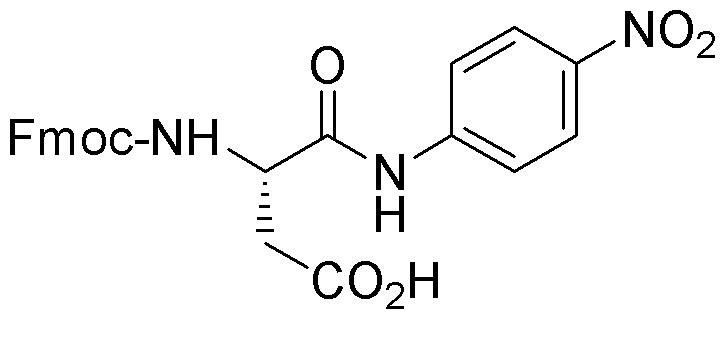Fmoc-L-aspartic acid a-4-nitroanilide is widely utilized in research focused on:
- Peptide Synthesis: This compound serves as a key building block in the synthesis of peptides, particularly in solid-phase peptide synthesis, allowing researchers to create complex peptides with specific sequences.
- Drug Development: It plays a significant role in medicinal chemistry, where it is used to design and develop new pharmaceutical compounds, particularly those targeting neurological disorders.
- Fluorescent Probes: The compound can be modified to create fluorescent probes for biological imaging, enhancing the visualization of cellular processes in research and diagnostics.
- Bioconjugation: It is employed in bioconjugation techniques, linking biomolecules to therapeutic agents or imaging agents, which is crucial in targeted drug delivery systems.
- Research in Neuroscience: The compound is utilized in studies investigating neurotransmitter pathways and receptor interactions, contributing to the understanding of various neurological conditions.
General Information
Properties
Safety and Regulations
Applications
Fmoc-L-aspartic acid a-4-nitroanilide is widely utilized in research focused on:
- Peptide Synthesis: This compound serves as a key building block in the synthesis of peptides, particularly in solid-phase peptide synthesis, allowing researchers to create complex peptides with specific sequences.
- Drug Development: It plays a significant role in medicinal chemistry, where it is used to design and develop new pharmaceutical compounds, particularly those targeting neurological disorders.
- Fluorescent Probes: The compound can be modified to create fluorescent probes for biological imaging, enhancing the visualization of cellular processes in research and diagnostics.
- Bioconjugation: It is employed in bioconjugation techniques, linking biomolecules to therapeutic agents or imaging agents, which is crucial in targeted drug delivery systems.
- Research in Neuroscience: The compound is utilized in studies investigating neurotransmitter pathways and receptor interactions, contributing to the understanding of various neurological conditions.
Documents
Safety Data Sheets (SDS)
The SDS provides comprehensive safety information on handling, storage, and disposal of the product.
Product Specification (PS)
The PS provides a comprehensive breakdown of the product’s properties, including chemical composition, physical state, purity, and storage requirements. It also details acceptable quality ranges and the product's intended applications.
Certificates of Analysis (COA)
Search for Certificates of Analysis (COA) by entering the products Lot Number. Lot and Batch Numbers can be found on a product’s label following the words ‘Lot’ or ‘Batch’.
Número de catálogo
Número de lote/lote
Certificates Of Origin (COO)
This COO confirms the country where the product was manufactured, and also details the materials and components used in it and whether it is derived from natural, synthetic, or other specific sources. This certificate may be required for customs, trade, and regulatory compliance.
Número de catálogo
Número de lote/lote
Safety Data Sheets (SDS)
The SDS provides comprehensive safety information on handling, storage, and disposal of the product.
DownloadProduct Specification (PS)
The PS provides a comprehensive breakdown of the product’s properties, including chemical composition, physical state, purity, and storage requirements. It also details acceptable quality ranges and the product's intended applications.
DownloadCertificates of Analysis (COA)
Search for Certificates of Analysis (COA) by entering the products Lot Number. Lot and Batch Numbers can be found on a product’s label following the words ‘Lot’ or ‘Batch’.
Número de catálogo
Número de lote/lote
Certificates Of Origin (COO)
This COO confirms the country where the product was manufactured, and also details the materials and components used in it and whether it is derived from natural, synthetic, or other specific sources. This certificate may be required for customs, trade, and regulatory compliance.


